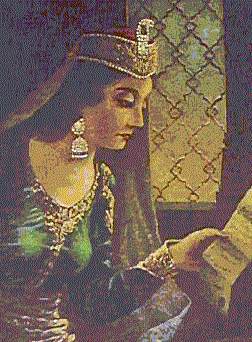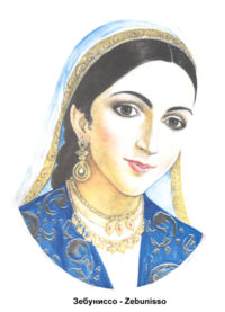
Being a favourite, she was exposed to the affairs of the Mughal court. With a sound education in the arts, languages, astronomy and sciences of the day, Zeb-un-Nissa turned into an aware and sensitive princess. She never married and kept herself occupied by poetry and a spiritual Sufi quest. This is the irony – Aurangzeb’s daughter was an antithesis of her father’s persona and politics. Zeb-un-Nissa was both a Sufi and a gifted poet. The Divan-i-Makhfi – a major divan – is credited to her name. Given her father’s dislike for poetry, she could only be makhfi – the invisible. There was subversion too – like all rebels she attended and participated in the literary and cultural events of her age, dressed in her veil.
Unlike her puritanical father, Zeb-un-Nissa did not share her father’s orthodox views on religion and society. Steeped in mystic thought, her ghazals sang of love, freedom and inner experience:
“Though I am Laila of Persian romance
my heart loves like ferocious Majnun
I want to go to the desert
but modesty is chains on my feet.
A nightingale came to the flower garden
because she was my pupil
I am an expert in things of love.
Even the moth is my disciple!”
(translated by Willis Barnstone)
Her verses, comprising 400 ghazals, and published as Divan-i-Makhfi would have bothered Aurangzeb. Her inclusive poetic vision ran against the puritanical state and society that Aurangzeb cherished.
I bow before the image of my Love
No Muslim I
But an idolater
I bow before the image of my Love
And worship her
No Brahman I
My sacred thread
I cast away, for round my neck I wear
Her plaited hair instead
(Divan-e-Makhfi)

This garden, in the pattern of Paradise, has been founded
The garden has been bestowed on Mian Bai
By the beauty of Zebinda Begam, the lady of the age
 According to Latif, Mian Bai was the favourite female attendant of Zeb-un-Nissa. Shah Jahan Nama also throws some light on the gardens and their gift to the lucky Bai. Since Mian Bai had supervised the laying out of these gardens, the local people called it Mian Bai’s gardens. Respecting local opinion, Zeb-un-Nissa bequeathed these gardens to her favourite slave girl. Eventually, she fell out of royal favour, not for her eclectic pursuits but for the rebellion of her brother Akbar, who proclaimed himself as emperor in 1681. While the rebellion was short and unsuccessful, Zeb-un-Nissa kept corresponding with her exiled brother; this landed her imprisonment in a Delhi fortress until her death in 1702. A recent book, Captive Princess: Zeb-un- Nissa, daughter of Emperor Aurangzeb, attempts to examine the causes of her imprisonment, her worldview and reconstructs her life. The work highlights the political differences that she developed with her father and shows how alien Aurangzeb’s style of governance was to her soul. She never accompanied him on his Deccan campaigns. Jadu Nath Sarkar states that Zeb-un-Nissa died in Delhi and was buried in the ‘Garden of Thirty Thousand Trees’ outside the Kabuli gate.
According to Latif, Mian Bai was the favourite female attendant of Zeb-un-Nissa. Shah Jahan Nama also throws some light on the gardens and their gift to the lucky Bai. Since Mian Bai had supervised the laying out of these gardens, the local people called it Mian Bai’s gardens. Respecting local opinion, Zeb-un-Nissa bequeathed these gardens to her favourite slave girl. Eventually, she fell out of royal favour, not for her eclectic pursuits but for the rebellion of her brother Akbar, who proclaimed himself as emperor in 1681. While the rebellion was short and unsuccessful, Zeb-un-Nissa kept corresponding with her exiled brother; this landed her imprisonment in a Delhi fortress until her death in 1702. A recent book, Captive Princess: Zeb-un- Nissa, daughter of Emperor Aurangzeb, attempts to examine the causes of her imprisonment, her worldview and reconstructs her life. The work highlights the political differences that she developed with her father and shows how alien Aurangzeb’s style of governance was to her soul. She never accompanied him on his Deccan campaigns. Jadu Nath Sarkar states that Zeb-un-Nissa died in Delhi and was buried in the ‘Garden of Thirty Thousand Trees’ outside the Kabuli gate.
It is said that when the railway line was laid at Delhi, her tomb was demolished, and the coffin and the inscribed tombstone were shifted to Akbar’s mausoleum at Sikandara Agra. According to SM Latif, a poet versified her chronogram in the following words:
A fountain of learning, virtue, beauty and elegance,
She was hidden as Joseph was in the well
I asked reason the year of her death.
The invisible voice exclaimed: “the moon became concealed”
Latif writes that the last phrase mahmakhfi-shud cannot be adequately translated. Literally it means the concealed moon, but makhfi was also the nom de plume of Zeb-un-Nissa and there is a meaningful wordplay here. However, much as we make conjectures about a full life lived, a good measure of the passions and poetry of the princess shall remain concealed and quite un-translatable.
NOTE: an earlier version of this post was published by the Friday Times



















































Very good post. The thing i liked best in it is “mahemakhfi shud” its very romantic, sweet and delicate.
MQ, Thanks…glad you liked it..feel free to visit and leave comments. I hope Raza will excuse us for communicating in this post.:)
As far as I know Babur was a descendent of Timur Lung, who was a mongol ….that is how the word evolved into ‘Mughal’. He went on to conquer through Iran and then Central Asian Republics. He spoke Turkish and liked the Persian culture that is why people in that region seem to be a mix.
Zia,
That’s a beautiful poem. “Yahan pe kuch nahin badla.” For some reason I couldn’t leave a comment there. That’s why here.
Regarding Mongols being the ancestors of Mughals, I guess, the people in Cenral Asia must have Mongol genes in their gene pool. But didn’t Babur belong to Farghana Valley, which today is in Uzbekistan?
MQ saheb, I was also thinking about Zeb-un-Nissa street and wondering after whom it was named. For general knowledge there also used to be a digest called ‘Zeb-un-Nissa’ :)
Very nice post Raza.
MQ , As far I know Mughals were descendents of Mongol and Safavids were a mix.